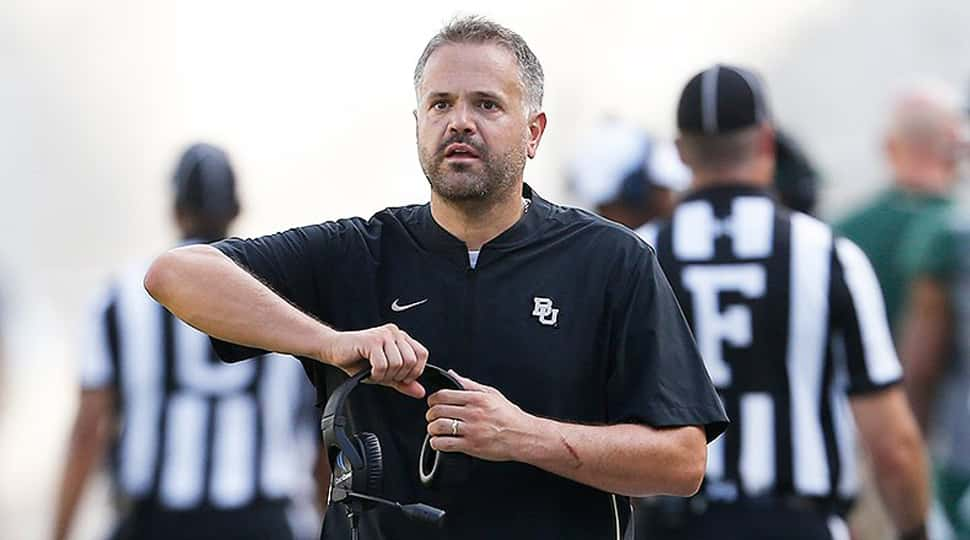
Matt Rhule’s Bears get another shot at Oklahoma on Saturday in AT&T Stadium
Baylor Bears head coach Matt Rhule has orchestrated an incredible turnaround in Waco. After losing 11 games in his first season in 2017, Rhule led Baylor to 11 wins during the ’19 regular season. And now, with an opportunity to avenge their only loss against the Oklahoma Sooners in the Big 12 Championship Game, it’s possible the Bears could sneak into the College Football Playoff.
But first things first. Baylor enters the Big 12 title game as an underdog and in order to pull off the upset, Baylor must exploit any edges – and potentially rely on a few old-fashioned concepts – to win the rematch.
5 Reasons Why Baylor Will Win the Big 12 Championship Game
1. Defensive efficiency
Believe it or not, Oklahoma leads the Big 12 in total defense, having allowed an average of 336.1 yards per game. Baylor, which has surrendered 352.8 yards per contest, ranks third.
But per-game measures can be flawed, and per-play statistics often provide a clearer picture of a unit’s overall effectiveness. Baylor leads the conference in yards allowed per play (4.77), which is well ahead of No. 4 Oklahoma (5.33). The Bears rank No. 18 nationally, while OU sits 42nd on the FBS leaderboard.
More importantly, Baylor held Oklahoma to 5.53 yards per play earlier this season, which was the lowest average of the season for the Sooners’ prolific offense.
2. Pressuring the passer
No Big 12 team has gotten to the quarterback more than Baylor. The Bears lead the conference with 40 sacks this season, which ranks ninth nationally. Defensive lineman James Lynch leads the league with 10.5 sacks and teammates Terrel Bernard, Blake Lynch and Bravvion Roy all rank among the top 10 in the Big 12 with 4.5 sacks apiece.
Of course, the Oklahoma offensive line is one of the best in the nation and has surrendered just 18 sacks in 341 pass plays this season – a 5.28 percent sack rate. But four of those sacks came against the Bears in 47 pass plays – or 8.51 percent.
3. Improved efficiency on third down
Oklahoma converted 12 of 18 third down opportunities in its win over the Bears this year. The Sooners were 8-for-8 on third down across five drives in the second half, four of which resulted in points to overcome a 31-10 halftime deficit.
Though quite better than its season average, Oklahoma’s 66.7 percent conversion rate for the game wasn’t much of an outlier for the Sooners. After all, OU ranks fourth nationally in third-down conversion rate (51.97 percent). But the performance was somewhat out of character for the Baylor defense, who had not allowed any other opponent to convert more than 50 percent of the time. The Bears rank a modest fifth in the Big 12 and 66th overall in defensive third-down conversion percentage (39.3 percent).
Had Baylor held the Oklahoma offense to that level in the earlier matchup, the Sooners would have faced five more fourth-down decisions. Even holding OU to its average could have stopped multiple scoring drives. The Baylor defense must get off the field when it has the chance.
4. Time of possession
We rarely hear coaches point to winning the time of possession battle in college football anymore. And it’s understandable given the success of fast-paced, quick-strike offenses like Oklahoma. But slowing down has its advantages. And for Baylor, the longer it possesses the football, the longer the Sooners must wait for an opportunity to score.
In its first game against Oklahoma, the Bears possessed the ball for 18:49, while the Sooners were on offense for 41:11. Some of that gap can be ascribed to two short Baylor touchdown drives in the second quarter that lasted a combined 0:12.
Nevertheless, had Baylor been able to hold onto the football for longer stretches in the second half, it could have limited Oklahoma’s odds for a comeback. Instead, the Bears lost a fumble on its first offensive play after halftime and followed with three straight three-and-outs. On its final drive, the Bears threw an interception.
None of Baylor’s five second-half drives lasted longer than 1:32, and the Bears averaged 1:21 per possession after halftime, giving Oklahoma more than 25 of the 30 minutes available to operate. It should come as no surprise the Sooners won 24-0 over the final two quarters.
5. Establishing the run
Like time of possession, “establishing the run” has become an old-fashioned term often mocked in college football analytics circles. Nevertheless, should Baylor rely more heavily on its run game against the Sooners this week, it could pay dividends. Especially given the progress the rushing attack has shown since the previous matchup with Oklahoma.
Baylor ran for 264 yards last week against Kansas, which marked a season-high in Big 12 play. The Bears did this damage on 47 carries, the second-most rushing attempts of the season. Part of the reason Baylor ran so much can be attributed to the flow of the game (a Baylor blowout) and part of its success can be attributed to the level of opponent (a poor Kansas run defense).
However, it’s also worth considering Baylor ran the ball just 23 times Oklahoma – fewer than any opponent the Sooners faced all year. Meanwhile, Kansas State – which beat Oklahoma 48-41 – ran the ball 45 times – more than any opponents the Sooners have faced this season. The Wildcats’ success on the ground also allowed them to dominate time of possession 38:08 to 21:52. It may behoove the Bears to follow a similar game plan.
— ATHLON SPORTS
